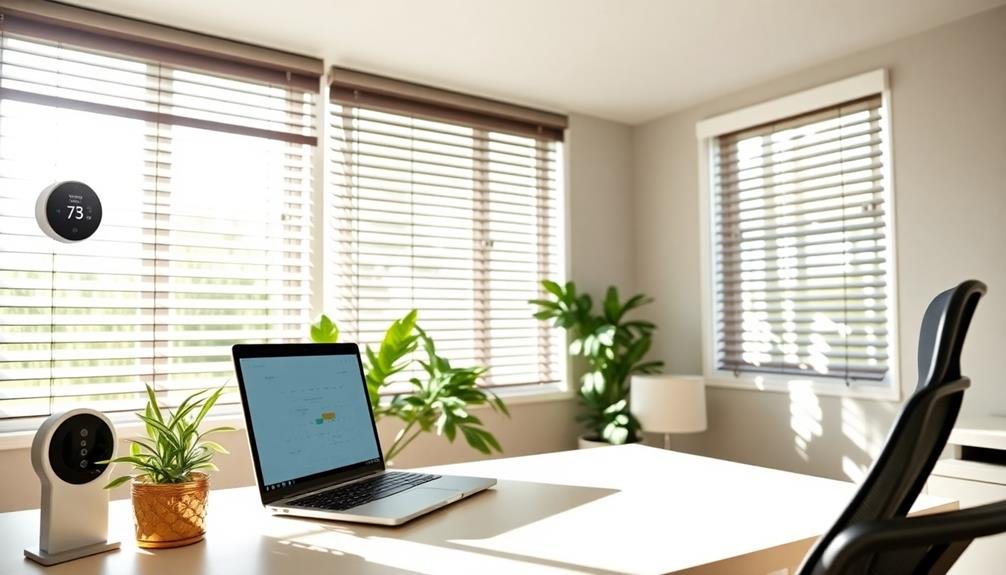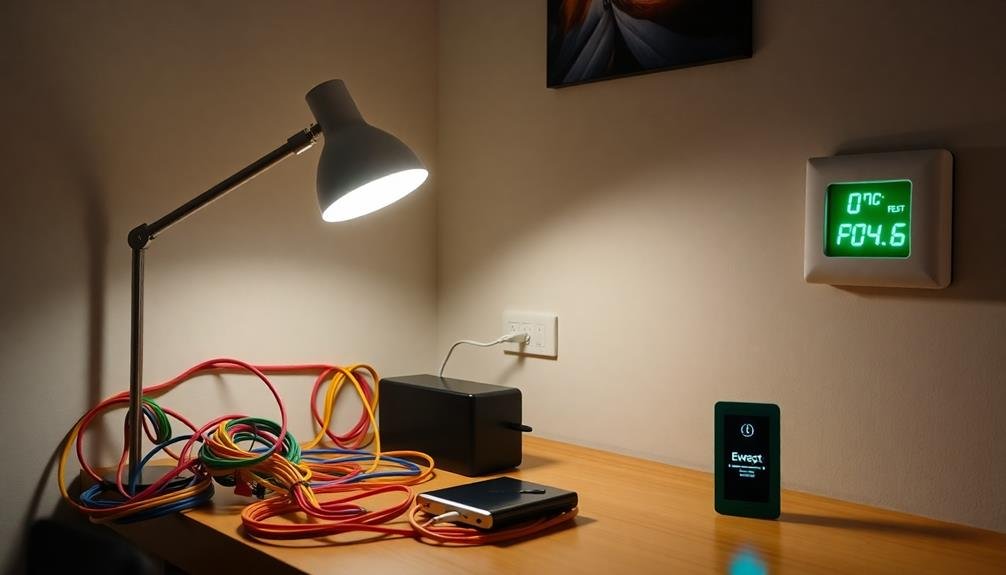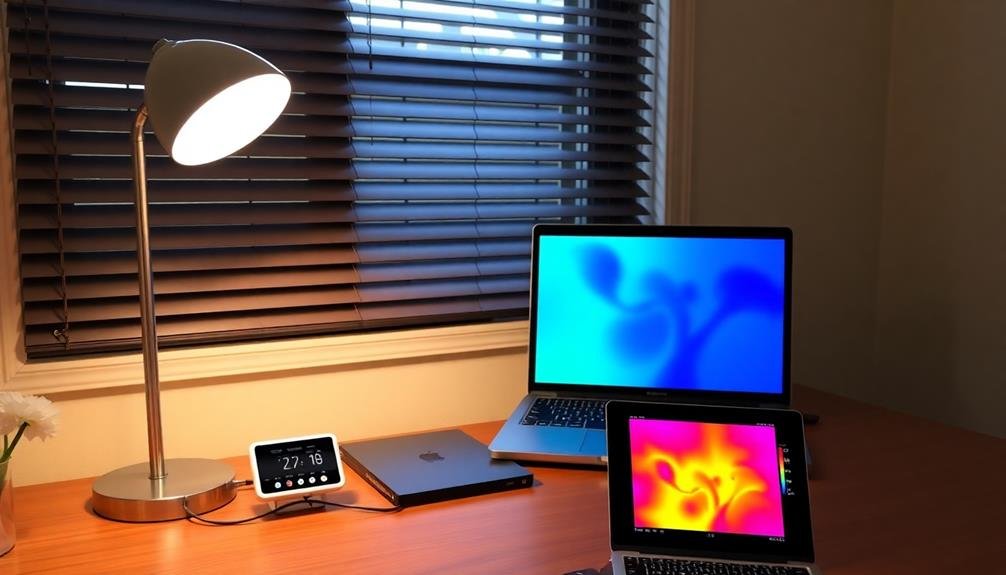You'll find that smart power meters have become essential tools for managing your home's energy consumption in 2025. As electricity costs continue to rise, these DIY monitoring devices offer you precise, real-time data about your power usage down to individual circuits. Whether you're looking to slash your monthly bills or embrace a more sustainable lifestyle, today's top smart meters combine advanced analytics with user-friendly features. Let's explore the leading options that can transform your home's energy efficiency.
SIEMENS Inhab Smart Home Energy Monitor with Circuit Level Sensors
The SIEMENS Inhab Smart Home Energy Monitor is ideal for homeowners who want thorough circuit-level tracking of their electricity usage, as it monitors up to 16 individual branch circuits plus main power feeds in real-time.
You'll get extensive insights through the mobile app, which works in the USA and Canada. The system includes 16-50Amp circuit sensors and 2-200Amp main sensors, supporting features like Time of Use Management and Peak Demand Management. It's compatible with both new and existing electrical panels.
While you'll need a licensed electrician for installation, the monitor's 4.5-star rating from 40 users confirms its effectiveness in identifying energy-hungry appliances and managing consumption.
Best For: Homeowners who want detailed, circuit-level monitoring of their electrical usage and are serious about optimizing their energy consumption through data-driven insights.
Pros:
- Comprehensive monitoring of up to 16 individual circuits plus main power feeds for detailed energy tracking
- Advanced features including Time of Use Management and Peak Demand Management
- High user satisfaction with 4.5/5 stars and proven effectiveness in identifying energy-hungry appliances
Cons:
- Professional installation required by a licensed electrician
- Mobile app limited to USA and Canada only
- Higher price point compared to basic whole-home energy monitors
Emporia Gen 3 Smart Home Energy Monitor with Circuit Sensors
Modern homeowners seeking thorough energy monitoring will find the Emporia Gen 3 an impressive solution with its 16 circuit-level sensors and real-time tracking capabilities. You'll get accurate readings within ±2% while monitoring everything from your AC to water heater through a user-friendly app.
The UL-listed device supports various electrical systems and connects via 2.4 GHz WiFi to deliver instant usage data. While installation fits most breaker boxes, you'll want to check available space first. Users report dramatic cost savings – some cutting monthly bills from $50 to $15 through informed decisions about energy usage. The system's automation features also help you optimize for time-of-use rates and peak demand programs.
Best For: Homeowners who want detailed, real-time energy monitoring across multiple circuits and are looking to reduce their electricity costs through data-driven decisions.
Pros:
- Highly accurate (±2%) real-time energy monitoring with 16 circuit sensors for comprehensive coverage
- User-friendly app interface with instant data updates and long-term usage tracking
- UL-listed certification and proven cost savings potential through automated energy management features
Cons:
- Requires adequate space in breaker box for installation of multiple sensors
- Depends on constant internet connectivity and Emporia's cloud services for functionality
- Limited notification customization options for abnormal energy usage alerts
Smart Home Energy Monitor with Real-Time Energy Tracking
Homeowners seeking thorough energy monitoring will benefit from this advanced Smart Home Energy Monitor, which combines robust tracking capabilities with user-friendly features. You'll get precise measurements through two 200A main circuit sensors and 16 branch circuit sensors, supporting various wiring configurations.
The system tracks your energy consumption 24/7 with 98% accuracy, storing up to 36 months of detailed data. You can monitor power, current, voltage, and power factor for major appliances through the Refoss app. The latest firmware update lets you invert readings directly in settings, while the clamp-on design guarantees easy installation without wire manipulation. Its seamless Home Assistant integration makes it ideal for smart home enthusiasts.
Best For: Homeowners and tech enthusiasts who want detailed energy consumption tracking, solar system monitoring, and smart home integration with Home Assistant.
Pros:
- Comprehensive monitoring with 2 main circuit sensors and 16 branch circuit sensors providing detailed power usage data
- Long-term data storage of up to 36 months with 98% accuracy and real-time tracking capabilities
- Easy installation with clamp-on design and direct Home Assistant integration without custom firmware requirements
Cons:
- Higher price point compared to basic energy monitors in the market
- Installation instructions could be clearer according to user feedback
- Limited user ratings (only 13) make it difficult to fully assess long-term reliability
Universal Electric kWh Meter – EKM Omnimeter Pulse v.4
Power-conscious DIY enthusiasts will find the EKM Omnimeter Pulse v.4 to be a thorough solution for monitoring home energy usage. This compact device works with any electrical system up to 480V and delivers over 40 data points per reading, giving you unprecedented insight into your power consumption.
You'll appreciate its versatility as it functions as three separate 120V meters in one unit. The meter's pulse-counting capability lets you monitor up to three additional pulse-output devices, while its relay control manages two external devices. It's cloud-enabled for remote monitoring, and its certifications, including California Type Approval and ANSI compliance, guarantee reliability. At just 12 ounces, this UL-listed meter installs easily and maintains a perfect 5-star rating.
Best For: DIY homeowners and energy-conscious consumers who want detailed power consumption monitoring and remote management capabilities for residential or light commercial electrical systems.
Pros:
- Highly versatile with ability to monitor any electrical system up to 480V and function as three separate 120V meters
- Comprehensive data collection providing over 40 different metrics per reading with cloud connectivity
- Well-certified and reliable with perfect customer ratings and strong manufacturer support
Cons:
- Higher price point compared to basic electrical meters
- May require technical knowledge for proper installation and setup
- Web software interface has had usability issues, though improvements have been made
SIEMENS Inhab Smart Home Energy Monitor with Circuit Level Sensors
The SIEMENS Inhab Smart Home Energy Monitor stands out for DIY enthusiasts who want granular control over their electricity usage. You'll get real-time tracking of up to 16 individual circuits plus whole-home monitoring through the main 200-amp sensors.
The system's advanced features include Time of Use Management, Peak Demand tracking, and Solar Management integration. While you'll need a licensed electrician for installation, the monitor's compact size (1.1 x 5.71 x 2.76 inches) fits most electrical panels. The mobile app, available in the USA and Canada, lets you analyze current and historical energy data to identify power-hungry appliances and optimize your consumption. With a 4.5-star rating, users praise its effectiveness in reducing energy costs.
Best For: Homeowners and DIY enthusiasts who want detailed, circuit-level electricity monitoring and are serious about optimizing their energy consumption and costs.
Pros:
- Comprehensive monitoring of up to 16 individual circuits plus whole-home energy tracking
- Advanced features including Time of Use Management and Solar Integration capabilities
- High user satisfaction with 4.5/5 stars and proven effectiveness in identifying energy waste
Cons:
- Requires professional installation by a licensed electrician
- Mobile app limited to USA and Canada only
- Higher price point compared to basic energy monitors due to advanced features and multiple sensors
Emporia Gen 3 Smart Home Energy Monitor & Real Time Electricity Meter
Savvy consumers looking to optimize their home's energy consumption will find the Emporia Gen 3 Smart Home Energy Monitor an ideal solution for real-time power tracking. This UL-listed device supports multiple circuit panel types and delivers accurate energy data within ±2% through its user-friendly app.
You'll get instant insights into your power usage with 24/7 monitoring capabilities and up to 16 branch sensors for individual appliance tracking. The system stores 1-second data for 3 hours, 1-minute data for a week, and hourly data indefinitely. While installation requires sufficient breaker box space, the potential savings are substantial – some users report cutting their appliance energy costs by more than 70%.
Best For: Homeowners and energy-conscious consumers who want detailed, real-time monitoring of their electricity usage and are looking to reduce their energy costs through data-driven insights.
Pros:
- Highly accurate (±2%) real-time energy monitoring with comprehensive data storage and detailed usage graphs
- Supports multiple circuit panel types and can monitor up to 16 individual circuits/appliances
- UL-listed for safety with proven cost-saving potential through usage optimization
Cons:
- Installation can be challenging depending on breaker box space and configuration
- Requires constant internet connection and 2.4 GHz WiFi to function
- Dependency on Emporia's servers and app for data access and monitoring features
TP-Link Tapo Smart Plug Wi-Fi Mini (4-Pack)
Energy-conscious homeowners seeking affordable monitoring solutions will find exceptional value in the TP-Link Tapo Smart Plug Wi-Fi Mini 4-pack. At just $5 per plug, you'll get ETL-certified devices that handle up to 1800W loads while tracking your energy consumption through detailed charts and cost estimates.
You can control these compact plugs through Alexa, Google Assistant, or Samsung SmartThings, and program them to run high-consumption appliances during off-peak hours. The Tapo app lets you monitor usage remotely and set custom schedules, including sunrise/sunset timing. While the plugs don't maintain their "on" state after power outages, they offer reliable performance and surge protection to safeguard your devices.
Best For: Budget-conscious smart home enthusiasts who want to monitor their energy usage and remotely control multiple devices while maintaining reliable performance and safety standards.
Pros:
- Excellent value at approximately $5 per plug while offering premium features like energy monitoring and surge protection
- Comprehensive smart home integration with Alexa, Google Assistant, and Samsung SmartThings compatibility
- User-friendly setup process and compact design that doesn't block adjacent outlets
Cons:
- Devices may not automatically resume their "on" state following power outages
- Limited to 2.4GHz Wi-Fi networks only
- Energy monitoring feature lacks continuous kWh total tracking capability
Factors to Consider When Choosing Smart Power Meters for DIY Energy Monitoring
When choosing a smart power meter for DIY energy monitoring, you'll need to evaluate essential factors like installation safety requirements and the complexity of setup procedures. You'll want to check the device's real-time monitoring capabilities and data storage options, ensuring you can easily access your energy consumption information through user-friendly apps or web interfaces. The meter's compatibility with your existing smart home ecosystem and its circuit-level sensing features will determine how granular your energy tracking can be and how well it integrates with your other connected devices.
Installation Complexity and Safety
Before diving into smart power meter installation, you'll need to carefully evaluate several safety and complexity factors that could make or break your DIY project. Check if your chosen model requires professional installation by a licensed electrician, as working with electrical panels can be dangerous.
Verify that the meter matches your home's electrical configuration, whether single-phase or three-phase, and guarantee you have adequate space in your breaker box for installation. Look for devices that come with thorough installation guides and all necessary hardware to simplify the process.
Don't overlook safety certifications like UL listing, which confirms the device meets strict safety standards. These certifications are essential for protecting your home and family during both installation and ongoing operation of your smart power meter.
Real-Time Monitoring Capabilities
Having addressed installation safety concerns, let's focus on the monitoring features that'll shape your energy management success. Today's smart power meters offer extensive real-time tracking that lets you monitor your electricity consumption as it happens.
You'll benefit from detailed insights at both whole-home and circuit-specific levels, making it easier to identify which appliances consume the most power. The best meters maintain accuracy within ±2% and alert you instantly to unusual energy spikes. You can track usage patterns through various time intervals, from minute-by-minute data spanning a week to long-term hourly records.
This precise monitoring helps you make informed decisions about your energy use, spot inefficient appliances, and adjust your consumption habits for maximum savings.
Data Storage and Access
Since data storage capabilities directly impact your monitoring effectiveness, choosing the right smart power meter requires careful evaluation of how it handles information. You'll find significant variations in storage capacity, from basic models that keep minute-level data for just a week to advanced units offering years of hourly readings.
Look for meters that provide at least 36 months of historical data access, as this lets you analyze long-term usage patterns and seasonal trends. If you want to monitor your energy use remotely, select a cloud-enabled meter that offers internet connectivity. You'll also need to take into account data accuracy – opt for meters with ±2% accuracy or better to guarantee reliable readings. Real-time access capabilities are vital, so prioritize devices that update every second when you're actively monitoring.
Smart Home Integration Options
When selecting a smart power meter for your DIY setup, compatibility with existing smart home systems should be a top priority. You'll want to choose a device that works seamlessly with popular voice assistants like Alexa and Google Assistant for convenient control and monitoring.
Look for meters offering robust mobile app connectivity so you can track your energy usage from anywhere using your smartphone. The best options include programmable scheduling features that let you automate high-consumption appliances during off-peak hours to reduce costs. Integration with home automation platforms is essential, as it enables you to create custom energy-saving routines based on your consumption patterns. Additionally, prioritize meters with detailed analytics and reporting capabilities, which help you identify energy-hungry devices and optimize your household's overall power usage.
Circuit Level Sensing Features
Circuit level sensing represents a key advancement in smart power meter technology, enabling you to monitor individual circuits throughout your home. You'll find that modern meters offer between 16 to 50 Amp sensors, letting you track multiple circuits simultaneously for precise energy consumption data.
With real-time monitoring capabilities, you're able to identify which appliances are consuming the most power and make immediate adjustments to reduce your energy usage. Most systems store historical data for up to 36 months, giving you valuable insights into long-term consumption patterns. Through mobile apps, you can access detailed statistics and actively manage peak demand periods. Features like load shedding help you optimize energy use based on real-time data, making it easier to maintain efficient power consumption throughout your home.
Cost Vs Feature Balance
As you explore smart power meter options, balancing cost against features becomes essential for maximizing your investment. While basic models might seem attractive due to lower upfront costs, advanced meters with extensive monitoring capabilities often deliver better long-term value through enhanced energy management.
You'll want to assess the number of circuit sensors included, as more sensors enable tracking of multiple appliances simultaneously. Real-time monitoring and data storage features justify higher prices by providing actionable insights into your energy usage patterns. Consider whether the meter's mobile app offers user-friendly interfaces and meaningful analytics that'll help you optimize consumption.
Don't forget to factor in compatibility costs – some meters might require additional components or specific configurations to work with your existing electrical setup, which can impact your total investment.
Frequently Asked Questions
Can Smart Power Meters Detect Faulty or Deteriorating Household Appliances?
Yes, you'll find that smart power meters can detect unusual power consumption patterns and spikes that often indicate faulty appliances. They'll alert you when devices are using more energy than normal, suggesting potential problems.
Do Power Companies Offer Incentives for Installing Smart Meters?
Yes, many power companies offer rebates and incentives when you install smart meters. You'll often find discounts on your utility bills, time-of-use rate options, and cash bonuses for participating in energy-saving programs.
How Accurate Are DIY Smart Meters Compared to Utility Company Meters?
You'll find DIY smart meters are typically 95-98% accurate compared to utility meters, but they aren't certified for billing. They're still reliable enough to help you track energy usage and identify savings opportunities.
Will Smart Meters Work During Internet or Power Outages?
You won't have real-time monitoring during internet outages, but most smart meters store data locally. During power outages, they'll stop working completely unless they have battery backup power or cellular connectivity.
Can Multiple Users Access the Energy Monitoring Data Simultaneously?
Yes, you'll be able to share your energy monitoring data with multiple family members simultaneously. Most smart meters offer multi-user access through their apps, letting everyone track power usage from different devices anytime.





Leave a Reply